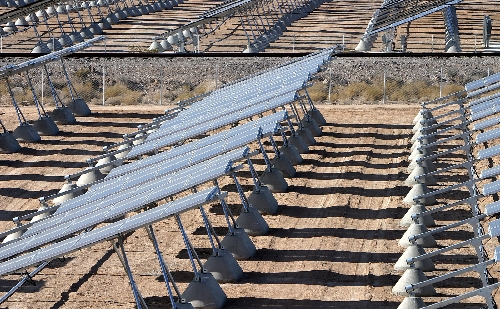With clean energy tax credits, developers could cultivate sun power zones in Nevada

A private company with water rights and a 612-acre holding in the proposed Dry Lake Valley solar zone could be the match to light the solar energy fire in Nevada.
"We’re not necessarily solar developers but what we are interested in being is a landlord to a solar developer in that part of the world," said Don Pattalock, vice president of Vidler Water Co. "We don’t have an active transmission line at this time but we have multiple developers interested."
But the corridors for two planned transmission lines flank the ranch property that Vidler acquired in 2008.
Pattalock sees where a development in Dry Lake Valley can get ahead in the government-backed race to develop solar energy.
"Everybody’s shooting for development by 2011 so they will qualify for investment tax credits," he said last week.
He made his comments before President Barack Obama came to town and called for Congress to support an additional $5 billion for tax credits to spur domestic manufacturing of renewable energy equipment, including solar photovoltaic panels.
In his speech at the University of Nevada, Las Vegas on Friday, Obama mentioned that a solar company, Amonix, had received $6 million tax credit for a new facility in the Las Vegas Valley, "a tax credit they were able to match with roughly $12 million in private capital," Obama said. "The only problem we have is these credits are working so well, there aren’t enough tax credits to go around."
He urged Congress to invest $5 billion more in clean energy tax credits, enough to create 40,000 jobs and $12 billion in private sector investment. That translates to an additional 90,000 jobs.
But in order to get the ball rolling on solar energy in Nevada, developers will need to take advantage of special zones proposed for two valleys in Lincoln County. In a bipartisan effort, Sen. Harry Reid, D-Nev., and Rep. Dean Heller, R-Nev., last month submitted companion bills that would set up a framework for the Bureau of Land Management to lease federal land for sun power projects. The government would collect fees and royalties from developers and share them with state and local entities and set aside money for wildlife protection.
Nevada Wilderness Project Director John Wallin lauded the prospect for royalties.
"We think it’s a creative thing that will be good for the economy and wildlife," Wallin said. "It takes clean renewable energy that is inexhaustible and it creates a revenue stream to protect wildlife habitat around areas being developed."
Scot Rutledge, executive director of the Nevada Conservation League and Education Fund, said the solar royalty proposal would differ from royalties generated from oil and gas development, which puts more emphasis on rehabilitating land than on habitat conservation or wildlife.
"This legislation serves as a model for a change in that paradigm: Rather than coming back later with reclamation, build it into the process," he said.
The companion bills call for revenue sharing with 25 percent of fees and royalties to the state and 25 percent to the county. For the first 10 years, 15 percent would be steered to the BLM to expedite renewable energy permitting, and 35 percent would go to wildlife mitigation. After 10 years, the wildlife fund would receive 50 percent. There were no estimates of how much revenue might be generated.
Rutledge stressed the need for accountability. "It doesn’t matter if you’re pro-conservation or pro-whatever. If you think about renewable energy development in Congressional District 2 … it has the largest renewable energy in the country, per capita."
While solar panels on Vidler’s Dry Lake holding wouldn’t generate royalties, it has the potential to power 100,000 homes. Solar developers on Vidler’s property could generate revenues to get a foothold in the market before expanding onto public land, Pattalock said.
In order to generate solar power, a developer would need three things in addition to lots of rays from the sun: land to build them on, water for power generation and an efficient way to transmit power to urban areas.
Vidler’s ranchland in Dry Lake Valley can start power generation while environmental impacts are assessed on public lands and lease arrangements are secured in the solar zones.
"Solar energy was one of the opportunities we saw out there. We’re working with (Lincoln) County and the BLM as well," Pattalock said.
"We know we have a good site. We’re hoping something shakes loose hopefully in the next 12 months."
Contact reporter Keith Rogers at krogers@reviewjournal.com or 702-383-0308.